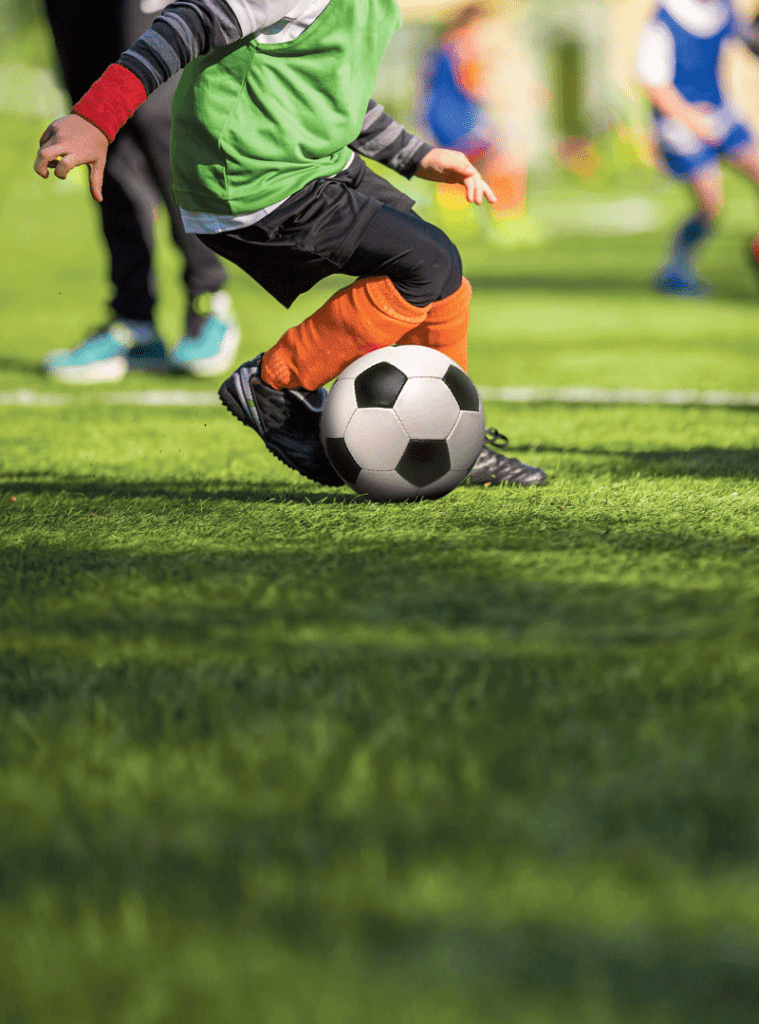Too Much, Too Fast, Too Soon – Overuse Injuries Are Common in Young Athletes
You’ve seen him — or her. The promising young pitcher with loads of raw talent and parents who see a college scholarship down the road. So, after playing on both a school team and a city league in the spring, the kid signs up for a traveling summer league. And then a fall league. Can’t slow down — gotta keep those skills up.
Until the inevitable elbow damage requires Tommy John surgery.
“Each year, we see younger and younger kids specializing in one sport, spending more than eight or nine months playing one sport, focusing on it year-round, five or six years in a row,” said Dr. Zachary Schepart, who specializes in pediatrics and sports medicine at RiverBend Medical Group.
Indeed, a 2015 survey in the American Journal of Sports Medicine found that 60{06cf2b9696b159f874511d23dbc893eb1ac83014175ed30550cfff22781411e5} of all Tommy John surgeries in the U.S. are for patients ages 15 to 19. “That’s amazing — or appalling,” Schepart said. “That’s a significant injury that results from repetitive use over time.”
By contrast, the former pitcher whose name became forever linked with the procedure — a then-groundbreaking surgical graft to repair a damaged elbow ligament — was 31 when he went under the knife. In response to the growing trend of Tommy John surgeries in teenagers, the American Orthopaedic Society for Sports Medicine launched the STOP (Sports Trauma and Overuse Prevention) Sports Injuries campaign in 2010.
The broad topic of overuse injuries, especially among young people, is one that Dr. Julio Martinez-Silvestrini, medical director of Baystate Rehabilitation Care, has been talking about for many years.
“Overuse injuries are related to training errors,” he told HCN. “One of the biggest problems we have is athletes specializing too early. It’s important for kids to participate in different types of sports, where each sport has different elements of strength, conditioning, aerobic capacity, coordination, explosive strength — all these things are different, so every sport is a little bit different.”
The second problem, in many cases related to the first, is athletes playing for more than one team at once, he said. Major League Baseball, recognizing this problem among young pitchers, launched a website, Pitch Smart, that highlights the dangers of throwing too much and too often.
“A lot of the concepts they mention on the website can be extrapolated to other sports — for example, playing for more than one team; you may have athletes that play for a school team and a club team,” Martinez-Silvestrini said. “One of their recommendations is that athletes should have between three and four months of rest a year, so you should not be playing year-round, and two of those four months should be consecutive. It’s not like taking two weeks here and two weeks here — you have to shut it down.”
Consider a young runner. An athlete may run for fun during the summer, then participate on a cross-country team in the fall, an indoor track team in the winter, and an outdoor team in the spring, but view them as three different sports, when, in fact, they all involve running, which can lead stress fractures of the lower leg and ankle, a common overuse injury in that discipline.
The American Academy of Pediatrics says half of all sports-medicine injuries in children and teens today result from repetition or overuse. Young people are especially vulnerable because their bones are still growing, which makes them less resistant to stress. Meanwhile, they are playing at higher levels than in the past and are often uneducated about symptoms related to overuse, and when something does hurt, they compensate by changing their movement patterns, which can lead to additional problems.
Martinez-Silvestrini said the concept of overuse can apply to a long period of time, or a short, intense burst of training.
“I like to use the concept of the terrible toos — too much, too fast, too soon,” he explained. “If you do way too much, or if you ramp up way too fast — for example, getting ready for a spring race, and you haven’t been training the whole winter and want to pack a month of training into a week or two — or course you can hurt yourself. Those are some of the main problems.”
Practice Makes Imperfect
Overuse injuries rank among the most common type of sports-related injuries Martinez-Silvestrini sees.
“Classically, sprains, strains, and muscle contusions occur at the moment of the game, more of an acute injury. Someone hits you, or you sprain an ankle. Overuse injuries tend to be related to training, and rarely occur after an acute event.”
They affect athletes in all sports, from volleyball to swimming, from gymnastics to soccer. In baseball, one type of injury is so common that the name ‘Little League elbow’ has become part of the lexicon.
One common condition in many sports is overuse of the heel and elbow, which can lead to a degenerative condition called tendinopathy. Tendons are the tough fibers that connect muscle to bone and can become weak over time.
“There tends to be a continuum,” Martinez-Silvestrini said. “They develop bursitis, don’t do anything about it, and it becomes tendinitis. If you don’t do anything about about that, it becomes tendinosis, and if you still don’t do anything, you may end up with a complete tendon tear. That’s why we recommend these kinds of ailments be treated early.”
Schepart noted that the type of overuse injury depends on the sport — baseball pitchers are more prone to shoulder and elbow injury, for instance, while soccer players are at risk of ankle injuries — but all are at greater risk by not following some basic guidelines for giving the body needed rest.
“If kids participate in sports more than eight months a year, they will be more likely to develop overuse injuries,” he said. “Think of a soccer player running around and kicking, using the same muscle groups over and over again. You can see why chronic ankle injuries don’t have a chance to get better when you’re playing in three separate leagues, six or seven days a week. You’re not allowing time for true healing.”
As for parents who insist on giving their kids an edge with year-round, specialized competition, Schepart noted that 88{06cf2b9696b159f874511d23dbc893eb1ac83014175ed30550cfff22781411e5} of college athletes played more than one sport, so even high-level performers don’t have to focus on just one sport to succeed past their high-school years.
“Making adequate time for rest is a huge thing,” he told HCN. “Kids are playing in three leagues because their parents think that’s how to get a scholarship, but if you don’t back off and take appropriate breaks, you’ll have a problem.”
Besides mixing different kinds of athletics and creating downtime during the week, Martinez-Silvestrini said, another way of preventing overuse injuries is to make just one change in training at a time.
Say, for example, an athlete is doing a specific type of exercise three times a week, with three sets of 10 each time. Going from three times a week to four is fine, or increasing the number of repetitions, but not both, he explained. “If you go to four times a week, five sets, and increase the repetitions to 15, you’re changing way too much, way too fast, way too soon, and that can actually result in an overuse injury.”
Other training errors are as simple as equipment that doesn’t fit properly or shoes that are too worn. “Shoes should be changed every 300 to 600 miles — maybe every three to six months. That’s important.”
The type of surface an athlete trains on can exacerbate injury as well, he noted. “For instance, we have an athlete who was running on her track and field team, but running on concrete, and she actually ended up having a stress fracture related to the extra force of the concrete surface. We usually recommend someone run on track — or at least grass or blacktop. We don’t recommend anything harder than blacktop.”
Eat, Drink, and Be Hydrated
Lifestyle away from the playing field impacts injury risk as well, Martinez-Silvestrini said, and not sleeping well or eating correctly can play a role.
“It’s very important to rest for the training to work. You also need to have good nutrition because what you’re doing is breaking muscle and building stronger muscle.”
For those who haven’t worked out in a while — in the spring, for instance, after a cold New England winter — it’s important to ramp up slowly. “Listen to your body, build gradually, and take your time.”
Proper hydration is critical as well, he explained, including two drinks of fluids before working out, two afterward, and one every 15 to 20 minutes during activity. Water is generally ideal, he added, but for activities that last longer than an hour, he recommends sports drinks because they contain glucose to replenish the body’s sugars — and, because athletes tend to like the flavor, they’re likely to drink more.
All this may seem basic, he told HCN, but it all falls under the category of educating athletes so they understand how every decision they make during training or practice can increase or reduce the chances of injury. Even baseball and softball players who follow Pitch Smart’s advice need to understand that the recommended pitch counts include practice throws.
“If you’re practicing a new curveball, any throw you do as part of your practice throws, you need to add it to that count,” Martinez-Silvestrini said. “It really adds up very fast. The idea is, you don’t want athletes overstressing their growth plates or ligaments, which may end up causing significant damage to the joint that can require surgery. These things can be prevented.”
Even concussions — brain traumas that are, of course, in their own, very serious category when it comes to sports injuries — can be exacerbated by overuse injuries in other areas of the body, Schepart pointed out. “If you have a nagging ankle injury, your head might be down because you’re worried about your ankle; that’s a huge risk factor for concussions.”
Parents and coaches need to be aware of signs a young athlete might be injured, as teenagers, in particular, are typically reluctant to admit to being hurt and losing playing time. For example, a cartilage tear in the shoulder, often referred to as a ‘slap tear,’ is a common injury seen in swimmers and baseball, tennis, volleyball, and softball players, and will result in pain when the person brings their hand up over their head. Other injuries have their own telltale signs which adults need to look out for.
“We do a lot of community outreach programs with our physical therapists,” Martinez-Silvestrini said, “because these concepts are very important and may not be conveyed because sometimes coaches have been trained in a different time, and may not be current with the most recent advances in sports medicine. They need to understand there are ways of doing it that are safer to the athletes.”





Comments are closed.